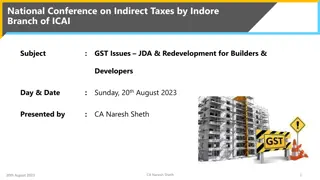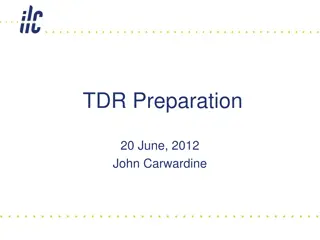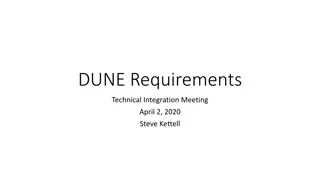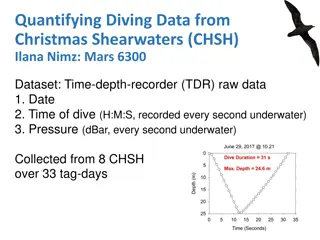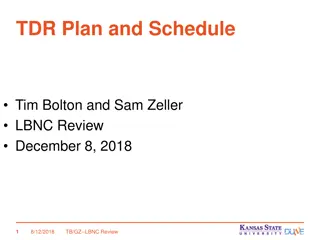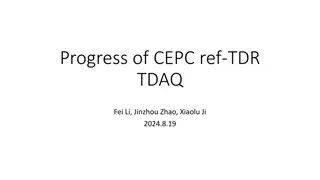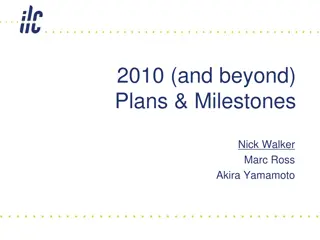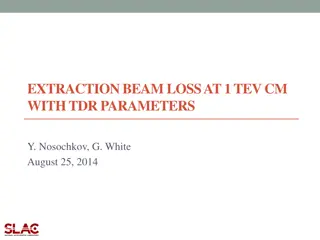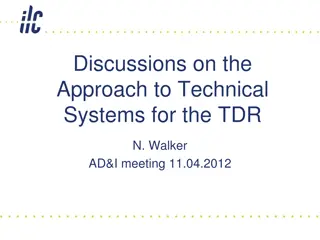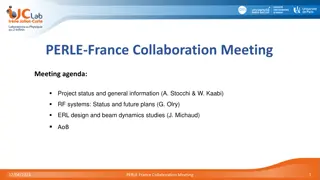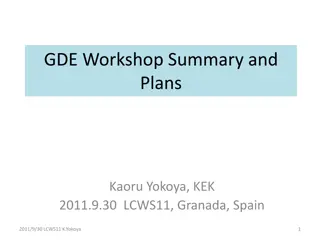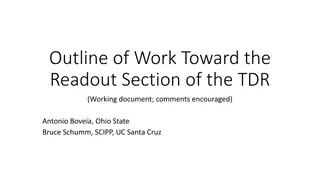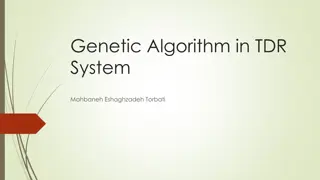
Plasma-Based FEL Lasing in Water-Window: WA8 Project Summary
"Explore the scientific case for plasma-based SASE FEL lasing in the water-window and design the experimental endstation for seeded FEL lasing. Detailed chapters cover the scientific case and experimental techniques for imaging, scattering, and spectroscopy measurements."
Download Presentation

Please find below an Image/Link to download the presentation.
The content on the website is provided AS IS for your information and personal use only. It may not be sold, licensed, or shared on other websites without obtaining consent from the author. If you encounter any issues during the download, it is possible that the publisher has removed the file from their server.
You are allowed to download the files provided on this website for personal or commercial use, subject to the condition that they are used lawfully. All files are the property of their respective owners.
The content on the website is provided AS IS for your information and personal use only. It may not be sold, licensed, or shared on other websites without obtaining consent from the author.
E N D
Presentation Transcript
@ WA8 Scientific Case Francesco Stellato University of Rome Tor Vergata & INFN on behalf of the WA8 collaboration team June 27th, 2024
WA 8 Users WA8 Project Summary Build up the scientific case and gather a users community for a plasma-based SASE FEL lasing in the water-window (around 4 nm) & design the required experimental endstation + explore the potential of a seeded FEL lasing @ 50-180 nm Condense this information in two chapters of the Technical Design Report 1- Scientific case 2- Experimental Endstation
WA 8 Users Figures - Photon beam(s) parameters AQUAARIA Parameter Value Parameter Value Wavelength 50-180 nm Wavelength 4-10 nm 10 13 - 10 14 Photons/pulse 10 10 - 10 11 Photons/pulse on sample* Pulse duration 20/200 fs Pulse duration < 10 fs Repetition rate* 100 Hz Repetition rate** 100 Hz * An order of magnitude range is given, since final numbers will depend on the beamline optics ** Options to run @ 400 Hz are being explored
WA 8 Users Experimental Techniques Technique Samples Coherent imaging Cells, organelles, nanomaterials Water window for high-contrast hydrated samples Photon scattering Molecules, nanoparticles Structural and dynamical characterization X-ray Spectroscopy Warm-dense matter, organo-metallic compounds, magnetic materials K, L and M edges falling in the FEL energy range Photoelectron Spectroscopy Carbon-based materials, batteries, biomolecules Chemical dynamics Ion Spectroscopy Astrochemistry, biomolecules Radiation-matter interaction dynamics This is a general overview and, besides coherent imaging, these techniques are possible both at the baseline AQUA beamline and at the beyond-the-baseline ARIA Pump-probe experiments to perform time-resolved measurements
WA 8 Users TDR Status Two chapters: Chapter 4- Scientific case Depends (mainly) on: Chapter 11 (Undulators FEL parameters) Required for: Chapter 13 Writing readiness: 5% ; Techincal readiness: 25% Chapter 13 Experimental Endsation Depends (mainly) on: Chapter 11 (Undulators); Chapter 12 (Photon beamlines) Writing readiness: 15% ; Techincal readiness: 20% For the sake of the TDR, priority is currently given to Chapter 13, in order to define the main features of the instruments required to perform imaging, scattering and spectroscopy measurements.
WA 8 Users TDR Status Scientific Case The index has been prepared Outline of the scientific goals, peculiar for an FEL operating in the soft X-ray region Description of the main experimental techniques: - Imaging - (Scattering) - Photon spectroscopy - Photoemission and ion spectroscopy
WA 8 Users TDR Status Experimental End-Station(s) The description is limited to the baseline AQUA Beam parameters will be taken from the Beamline chapter The main elements of ARIA will also be described A description at a qualitative level of the required components has been assembled. A more detailed description with technical specifications (spaces, requirements) is ongoning Data acquisition requirements relevant for the TDR are being evaluated
WA 8 Users TDR Status The AQUA instrument - Implementation of the experimental techniques described in the Scientific case - Photon beam parameters (size, divergence) from the beamline chapter - Flexible and modular design to ease the integration with ARIA and to allow users to connect custom pieces of equipment
WA 8 Users TDR Status The ARIA Instrument - Beyond the baseline, therefore only general aspects and space/instrumentation constrains will be provided - Modularity in terms of sample injection systems, manipulators and detectors to minimize costs and optimize inter-operation with AQUA
WA 8 Users TDR Status Experimental Chamber Vacuumchamber to work in the soft X-ray region Relatively small, equipped with multiple ports to allow connecting different pieces of instrumentation: - Sample delivery systems - Detectors - Spectrometer (photon & ion) - External lasers Options to install tight-focusing elements (e.g. off-axis parabola)
WA 8 Users TDR Status Sample Delivery Systems Several sample delivery system will be provided, each one optimal for a given class of experiments/samples: - - - - - Fixed target stages Gas dynamic virtual nozzle Aerodynamic lenses Drop-on-demand injector Electrospray injector Modular to be connected also to the ARIA endstation Possibility to install custom, user provided systems
WA 8 Users TDR Status Detectors Photon detectors: - 2D, small pixel, fast-readout, high dynamic range detector for coherent imaging and scattering - 2D detector also for spectroscopy - 0D detector for spectroscopy
WA 8 Users TDR Status Detectors Electron detector To be defined Ion detector - High position sensitivity, large detection area, fine gridding to allow reconstruction of three-dimensional arrangement and motion of atoms within a molecule and distinguish between ions of different masses and charge states pattern orientation for CDI Modular design to facilitate their integration with other experimental setups, < 50 cm length -
WA 8 Users TDR Status Pump lasers Two laser sources are foreseen 1- Ti:sapphire fixed wavelength (800nm) femtosecond laser, with also the possibility of exploiting second (400 nm) and third (267nm) harmonics. 2- Optical Parametric Amplifier (OPA), with tens of femtosecond pulses in the 700-900 nm range. Options to go from UV to MIR.
WA 8 Users TDR Status Data Data acquisition acquisition and management and management - Data Acquisition (DAQ) system to store, on a shot-to-shot basis, FEL (number of photons, energy) and sample (motors positions, time-delay for pump-probe measurements) - 100 Hz imaging can produce up to 100 TB of data/day. PB of storage (part on hard-drive, part on tape) have to be available to users. - Fast access to the measured data for analysis during the experimental run. - Efficient on-line data reduction (or rejection) tools - The computer room should be located close to the experimental hutch to facilitate fast data streaming.
WA 8 Users Ongoing Actions Dissemination - presentation of EuPRAXIA@SPARC_LAB updates at o Science@FELs 2024 Paris, June 2024 European (and worldwide) FEL users community o SIBPA 2024 Genoa, June 2024 - Italian (and European) Biophysics community o SILS 2024 Arcavacata, September 2024 Italian (and European) synchrotron radiation community Gathering potential users both in condensed matter and biophysics and potential manpower 16
WA 8 Users Ongoing Actions Second users meeting organization in December 2024 (2nd-4th, to be confirmed) - Updating the potential users community about photon beams figures - Gather users requirements compatible with machine developments - Feedback from selected (and motivated) groups on the TDR level the description of the first experiments - Select few niche experiments optimal for the EuPRAXIA@SPARC_LAB FEL 17
WA 8 Users Ongoing Actions TDR writing Scientific Case chapter: Updating and expanding the CDR level description taking into account the better defined FEL patameters and input from the community Experimental Endstation chapter: gathering information from experimental endstations at operational facilities (Fermi, FLASH, EuXFEL) Quantitative definition of spaces and required services (gas lines/bottles, vacuum components, fast connection to computing resources)

